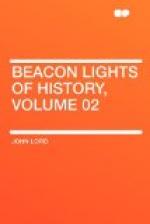The sojourn at Lystra was marked by the miraculous cure of a cripple, which so impressed the people that they took the missionaries for divinities, calling Barnabas Jupiter, and Paul Mercury; and a priest of the city absolutely would have offered up sacrifices to the supposed deities, had he not been severely rebuked by Paul for his superstition.
At Lystra a great addition was made to the Christian ranks by the conversion of Timothy, a youth of fifteen, and of his excellent mother Eunice; but the report of these conversions reached Iconium and Antioch of Pisidia, which so enraged the Jews of these cities that they sent emissaries to Lystra, zealous fanatics, who made such a disturbance that Paul was stoned, and left for dead. His wounds, however, were not so serious as were supposed, and the next day he departed with Barnabas for Derbe, where he made a long stay. The two churches of Lystra and Derbe were composed almost wholly of heathen.
From Derbe the apostles retraced their steps, A.D. 46, to Antioch, by the way they had come,—a journey of one hundred and twenty miles, and full of perils,—instead of crossing Mount Taurus through the famous pass of the Cilician Gates, and then through Tarsus to Antioch, an easier journey.
One of the noticeable things which marked this first missionary journey of Paul, was the opposition of the Jews wherever he went. He was forced to turn to the Gentiles, and it was among them that converts were chiefly made. It is true that his custom was first to address the Jewish synagogues on Saturday, but the Jews opposed and hated and persecuted him the moment he announced the grand principle which animated his life,—salvation through Jesus Christ, instead of through obedience to the venerated Law of Moses.
On his return to Antioch with his beloved companion, Paul continued for a time in the peaceful ministration of apostolic duties, until it became necessary for him to go to Jerusalem to consult with the other apostles in reference to a controversy which began seriously to threaten the welfare of their common cause. This controversy was in reference to the rite of circumcision,—a rite ever held in supreme importance by the Jews.




